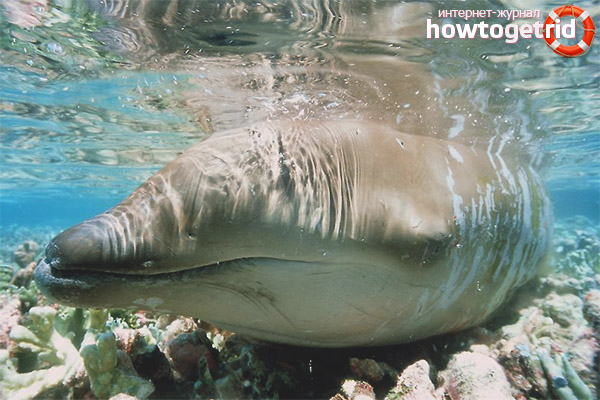The content of the article
Very little is known about the world of the ocean. He hides many secrets. His obscurity is often compared with the Cosmos. Only a small part of the flora and fauna of the ocean is known. Many animal species have not been studied or poorly studied. A striking example is the whale Klyuvoryl - a representative of cetaceans. His other name is Kuvier Klyuvoryl. Due to similar characteristics with other species, it is difficult for zoologists to study the behavior and abundance of the animal. In this regard, information on representatives is extremely small. The problem is that scientists most often can only investigate a species at a great distance. This method has many disadvantages, and one of them is defective data collection.
Appearance
The whale is medium in size. In length, individuals can reach 7 meters, and in weight - 3 tons. As a rule, females are slightly larger than males. The body is elongated and has a fusiform shape. A large head makes up about 10% of the entire body length. The beak is quite thick. Adult males have 2 large fangs on the lower jaw about 8 cm long. Females have no such fangs. However, some individuals studied had 15–40 rudimentary teeth. On the beak of the neck are grooves for breathing. Cubs are born large - about 2.1 meters.
Small flippers have the shape of a circle. If necessary, the whale folds them into special recesses on the body, the so-called flipper pockets. Upper fin high, similar to sharks, can reach 40 cm.
Color depends on the habitat. In the Pacific and Indian oceans, individuals of brown and dark yellow shades swim. The beak is gray-blue in the Atlantic, with a changed head shape and dark spots around the eyes. The abdominal part is paler than the dorsal. The head is almost always white.
Habitat and abundance
The species is also widespread in enclosed seas: Okhotsk, Caribbean and Japanese. The California and Mexican Gulfs are another habitat for Kluvoryl. This species is the only one of the cetaceans that live in the Mediterranean Sea. However, individuals are not found in the Baltic and Black Seas.
The exact number is difficult to establish. In 1993, a study of several habitats revealed 20 thousand individuals in the east and in the tropics of the Pacific Ocean. Later, a second study was performed. This time, scientists included all the lost individuals, and the number was 80 thousand. Only in the Hawaiian region, there are about 17 thousand individuals.
The beak is one of the most common species in the world from the cetacean family. Information on the exact population size is not available. However, according to approximate estimates, we can conclude that there are about 100 thousand individuals in the entire oceans.
Demeanor

Beaks prefer steep seabed in continental waters. Although some representatives of the species are found at a depth of 200 meters. As Japanese studies show, most often the beaks of the beaks live at great depths. The individual can be found in closed seas and near oceanic islands. Near the coast of the mainland, beak is rarely seen. However, exceptions include areas with deep coastal waters, as well as canyons. The species belongs to pelagic creatures (lives in the ocean), the isotherm is 100C, the contour is 1000M.
Diet
Like all representatives of the cetacean family, the beak is fed by the method of absorption of prey near itself. He likes to hunt at great depths or in the thickness of the ocean. There is data on the duration of the dive: about 40 minutes.
A favorite dish of whale are fish, squid and crustaceans. Information on the diet was obtained after studies of the digestive system of individual individuals.
Environmental impact
These representatives of the cetaceans are not actively hunted. There are rare cases when the beak falls into the clutches of hunters. This cannot be called a rule, but rather an exception to it.
How exactly the change in the marine climate affects beaks is still unknown, however, the very fact of the influence on the species has been established.
Video: beak (Ziphius cavirostris)










Submit